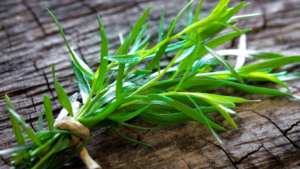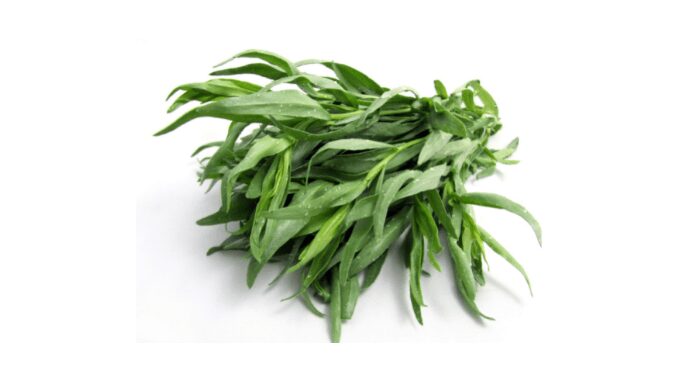Tarragon benefits: Quick look
|
Tarragon (Artemisia dracunculus L. Family Asteraceae) is a popular aromatic herb. It is also known as Marki or Estragon & has a long historical use as a spice and therapeutic. It has been used in folk medicine for the treatment of cough, cold, fever, pain, amenorrhea, and dysmenorrhea. Tarragon benefits are due to its anti-diabetic, anti-inflammatory, anticoagulant, antibacterial, antifungal, anti-cancer, and anti-leishmanial properties.
Geographical distribution
Tarragon is widely found in India, China, Japan, North America, and European countries.
There are 2 types of Tarragon available in the market
- French Tarragon is used as a spice in cuisine
- Russian or wild Tarragon is used medically in Russia and Middle Asia,
French tarragon and Russian tarragon differ dramatically in their aroma and flavor. French tarragon is favored for its spicy, licorice-like flavor and is used as a culinary herb. Whereas Russian tarragon is bitter and more often used medicinally, mainly to treat gastrointestinal disorders.
Nutritional value of tarragon
According to the United States, Food and Drug Administration (USDA) tarragon benefits are due to the rich source of protein, manganese, iron, magnesium, copper, potassium, zinc and other compounds per 100 g are as follows (1).
Compound |
Amounts per 100 g. |
| Water | 7.74 g |
| Energy | 295 Kcal |
| Protein | 22.77 g |
| Total lipid (fat) | 7.24 g |
| Carbohydrate | 50.22 g |
| Fiber, total dietary | 7.4 g |
| Calcium | 1139 mg |
| Iron, Fe | 32.3 mg |
| Magnesium | 347 mg |
| Phosphorus | 313 mg |
| Potassium | 3020 mg |
| Sodium | 62 mg |
| Zinc | 3.9 mg |
| Copper | 0.67 mg |
| Manganese | 7.96 mg |
| Vitamin C | 50 mg |
| Thiamin | 0.25 mg |
| Riboflavin | 1.34 mg |
| Niacin | 8.95 mg |
| Vitamin B-6 | 2.41 mg |
| Folate | 274 µg |
| Vitamin A, RAE | 210 µg |
| Vitamin A, IU | 4200 IU |
| Fatty acids, total saturated | 1.88 g |
| Fatty acids, total monounsaturated | 0.47 g |
| Fatty acids, total polyunsaturated | 3.69 g |
Tarragon benefits
Tarragon benefits are mainly due to compounds like α-and ß-thujones, thujyl alcohol, azulenes, bisabolene, cadinene, sabinene, pinene, and phellandrene. Therefore some of the tarragon benefits are as follows.

1. Effect of tarragon on athletes
Intake of glucose along with tarragon supplementation, after an endurance of exercise, did not cause any adverse effect in person. Because it increases serum insulin concentration while reducing blood glucose levels in the body, thus acting as a “recovery agent” (2).
2. Tarragon benefits to skin
The essential oil present in tarragon and flavonoids may act as an antiallergic and thus treat the skin against rashes, wounds, and other skin-related issues.
3. Boost immune system
Intake of tarragon water extracts helps to inhibit inflammation of the brain and other organs. This plant encourages the growth of white blood cells that engulf and digest bacteria and other harmful organisms thus modulating the immune system (3).
4. May treat pain and inflammation
Tarragon is beneficial to decrease pain intensity and swelling in the joints and increase the ability to handle pain, thus beneficial for the management of osteoarthritis (OA) of the hip or knee (4, 5).
5. Possible anti-diabetic properties
Tarragon contains α-and ß-thujones, thujyl alcohol, azulenes, bisabolene, cadinene, sabinene, pinene, and phellandrene. These active compounds help to decrease blood glucose levels and increase insulin levels, thus may treat diabetes in humans as well as animals (6).
6. Anticoagulant properties
The presence of coumarin compounds in tarragon leaves inhibits the clotting of the blood. Thus tarragon consumption may prevent the development and progression of many cardiovascular diseases such as atherosclerosis and thrombosis (7).
7. Antimicrobial properties
It fights against different bacteria such as Pseudomonas aeruginosa Shigella (RSHI), Listeria monocytogenes, and Escherichia coli by damaging its cell wall (8).
8. Potentially prevent obesity-related dysfunction
Although the intake of tarragon by obese people is not effective for the reduction of weight. However, it is beneficial to improve glucose utilization and prevent fat accumulation and the development of obesity-related risk factors (10).
9. May treat sarcopenic obesity
Obesity is also linked to age-related skeletal muscle loss, called sarcopenic obesity. However, tarragon alters enzymes that are essential regulators of skeletal muscle mass and thus may be useful for the treatment of obesity-linked sarcopenia (11).
10. May treat diabetic neuropathy
Diabetic neuropathy is a type of nerve damage that can occur with diabetes due to long-term high blood sugar levels. However, the ingestion of tarragon may help to treat nerve dysfunction and promote sensory nerve fiber regeneration (12).
11. May treat depression
Tarragon is an excellent source of phenolic and flavonoid contents that increase the level of serotonin in the central nervous system. Thus may treat depression, stress disorders, and anxiety by improving mood, and enhancing energy and positive thoughts (13).
12. Possible anti-leishmanial properties
Leishmaniasis is a parasitic disease spread by sandflies and presents in three main ways: cutaneous, mucocutaneous, or visceral (skin diseases). Tarragon contains artemisinin compounds that have the potential to potent antileishmanial activity and also enhance cellular immunity to this parasite (14).
Tarragon side effects
A research study suggested that Estragole (up to 82%) and methyl eugenol (up to 39%), found in tarragon essential oil increased the risk of liver cancer in mice. However, according to other reports, tarragon consumption presents no genotoxic or mutagenic risk to humans even at a high dosage (15).
Russian tarragon contains less amount of estragole than French tarragon. Furthermore, water extracts of tarragon contain a lack or low amounts of these compounds and, hence, are considered to be “safer” than ethanolic extracts.
Therefore, tarragon is safe to use as a dietary supplement or in functional foods. It did not cause any effects on organ mass or blood and lesion formation in the short term. However, no one knows the long-term effect of this plant, thus limiting the intake of such herbal spices is advised (16).
Q&A
Is Tarragon safe to eat?
Yes, Tarragon is safe when used in normal amounts, it can be used as a spice or a tea, and the maximum daily dose of dry plant material will be below 10 g/day (17).
Is Tarragon a strong herb?
Tarragon is an aromatic small shrubby perennial herb commonly used in French, and Iranian cuisine. and English cousins.
What is tarragon spice used for?
Tarragon spice is widely used in salads, sauces, pickles, chicken, fish, omelets, cheeses, vegetables, and also for medicinal purposes. Tarragon is also used in various drinks, infusions, vinegar, and mustard soups.
Is Tarragon a diuretic?
Traditionally tarragon has been used as a mild diuretic, however further study on humans is needed.
